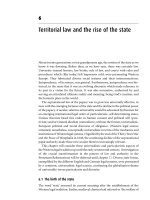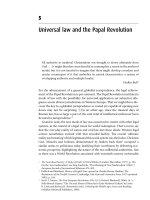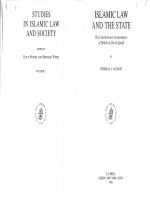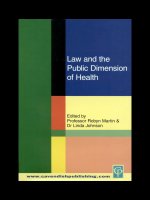Universal law and the Papal Revolution
Bạn đang xem bản rút gọn của tài liệu. Xem và tải ngay bản đầy đủ của tài liệu tại đây (124.31 KB, 18 trang )
5
Universal law and the Papal Revolution
All authority in medieval Christendom was thought to derive ultimately from
God . . . It might therefore seem fanciful to contemplate a return to the medieval
model, but it is not fanciful to imagine that there might develop a modern and
secular counterpart of it that embodies its central characteristics: a system of
overlapping authority and multiple loyalty.
Hedley Bull
1
For the advancement of a general, globalist jurisprudence, the legal achieve-
ment of the Papal Revolution is pre-eminent. The Papal Revolution instituted a
mode of law with the possibility for universal application yet subjective alle-
giance across diverse jurisdictions in Western Europe. That we might there dis-
cover the key to a globalist jurisprudence so rusted yet capable of opening new
doors may not be surprising. ‘[I]n no other age, since the classical days of
Roman law, has so large a part of the sum total of intellectual endeavour been
devoted to jurisprudence.’
2
Grand in scale, the new mode of law was conceived to coexist with other legal
systems, in the context of a legal vision for world redemption. That is not to say
that the everyday reality of canon and civil law met these ideals. Western legal
science nonetheless evolved with that encoded facility. The crucial ‘ultimate
reality and meaning’which legitimated this social system was the Judeo-Christian
God. Miracles and holiness demonstrated by leaders back then
3
occupied a
similar status to politicians today justifying their worthiness by delivering eco-
nomic prosperity, highlighting the nature of the two millennial authorities. Just
as there was a World Revolution associated with twentieth-century universalist
11
The Anarchical Society: A Study of Order in World Politics (London: Macmillan, 1977), p. 254.
On the ‘new medievalism’, see Jörg Friedrichs, ‘The Meaning of New Medievalism’ (2001) 7
European Journal of International Relations 475–502.
12
Pollock and Maitland, History of English Law, quoted in Charles Homer Haskins, The
Renaissance of the Twelfth Century (Cambridge, MA: Harvard University Press, 1927 reprinted
1993), p. 194.
13
See R. I. Moore, The First European Revolution: 970–1215 (Oxford: Blackwell, 2000), ch. 1;
Sofia Boesch Gajano, ‘The Use and Abuse of Miracles in Early Medieval Culture’ in Lester
K. Little and Barbara H. Rosenwein (eds.), Debating the Middle Ages: Issues and Readings
(Malden: Blackwell Publishers, 1998).
norms, so too was there a revolution of Western European compass with univer-
salist norms in the late eleventh, early twelfth centuries.
5.1 Apocalypse
In the face of numerous collectives of allegiance at the beginning of the sec-
ond millennium, political power was severely contested. The collapse of the
Carolingian empire bifurcated the universalism of imperial constitutionalism.
Emerging from the collapse was a purported papal universality inherited by the
clans of the Roman aristocracy, and a purported imperial universality inherited
by the fluid Italian nobility and ultimately, from 962, the German sovereigns.
4
So ended what is sometimes referred to as the first of the two feudal eras.
Profound social discord was characterised by the trust placed in the sword to
cure social ills. In the original European Community of the middle ages, vio-
lence played an important role in the economy. Plunder provided an opportu-
nity to prosper at a time when trade was elusive. The economy, as previously
discussed, was fragmented and disorganised and subject to localised and idio-
syncratic market controls – a far cry from a nationally organised economy let
alone a global economy. Customary law could be used as a legal basis for ‘almost
every usurpation’ and law was taken into private hands in the manner of the
family blood feud. Men, quick as a point of honour to display animalistic
strength, ‘were emotionally insensitive to the spectacle of pain, and they had
small regard for human life, which they saw only as a transitory state before
Eternity’.
5
The end of the world appeared nigh for some Christians who had
been waiting for heaven on earth since Christ when the early Christians had
foretold relief from the evil empires in the first century.
6
Beginning in the tenth century, the Peace Movement was an attempt by certain
bishops ‘to organise peasants and other non-combatants into a sort of vigilante
association to repress the violence and pillaging of feudal lords’, lacking, though,
in success, because the lords were usually militarily superior. Fortunes of the
Movement improved when powerful lords took up the cause for political stabil-
ity. The church assumed a secondary role and simply sanctioned the lay rulers.
7
Civil war was, however, to rage sporadically throughout Europe from 1075.
The premier European drama was unfolding in the wings. The high achieve-
ments which would follow gave rise to phrases such as ‘The Twelfth-century
Renaissance’, ‘The Making of the Middle Ages’, ‘The Rise of Europe’, ‘The
Flowering of Medieval Civilisation’ and ‘The Intellectual Expansion of Europe’.
8
96 A Holy Roman Empire
14
Marc Bloch, Feudal Society, trans. L. A. Manyon (London: Routlege & Kegan Paul, 1942),
p. 390.
5
Ibid., p. 411.
16
See Richard Landes, ‘The Fear of an Apocalyptic Year 1000: Augustinian Historiography,
Medieval and Modern’ (2000) 75 Speculum 97–145.
17
Joseph R. Strayer, On the Medieval Origins of the Modern State (Princeton: Princeton
University Press, 1970), pp. 19–20. See too Alan Harding, Medieval Law and the Foundations of
the State (Oxford: Oxford University Press, 2002), ch. 4 and sources therein.
18
Norman Cantor (ed.), The Medieval Reader (New York: HarperPerennial, 1995), p. 87.
5.2 The Papal Revolution
5.2.1 Space: the reconciliation of morality and politics
Amidst the extraordinary affliction of ‘tribulations and difficulties’ causing
‘tranquillity and peace’ to be ‘wholly despaired of’ (paraphrasing the Bishop of
Cologne)
9
in this era, peace associations emerged, in meetings of bishops, led
by the Cluniac monks. (The monastery at Cluny was perhaps the prototype
multinational corporation, with branch monasteries throughout Europe
10
including England.) Certain ideological beliefs sought institutional expression
in this chaotic society: for example, to kill a Christian is to kill Christ. Not only
was there a duty on the part of the church to protect its own members but there
was also a duty to protect the poor and wretched, who had been entrusted to
the church. Belief in the state, remembered from imperial times, tended to
oppose clerical interference in the temporal matter of peace, although, particu-
larly in France, the powerlessness of the monarchy was evident.
11
On the Space Axis of the Space–Time Matrix, interior, popular movements
filled in for the imperial state. Special days in the calendar spread and drew pro-
hibitions on blood feuds (Sundays) and bans on violence, for example, over the
Easter period (known as the ‘Truce of God’);
12
protection was extended to
church property, unarmed clerics, peasants’ livestock and later, merchants,
despite some exceptions in times of war (the ‘Peace of God’).
13
These restric-
tions were developments in the ideology of the ‘Just War’.
14
Peace decrees from
provincial church synods generally forbade, ‘under pain of excommunication,
any act of warfare or vengeance against clerics, pilgrims, merchants, Jews,
women, and peasants, as well as against ecclesiastical and agricultural prop-
erty’.
15
Collective oaths of reconciliation and good conduct were undertaken in
the form of ‘pacts’, although these were not always voluntary, for the church
might take hostages and enforce a pledge of peace (for example, in Le Puy, 990).
These collective oaths played an important role in the later formation of cities,
guilds and corporate groups. Some of these communities set up militia and
appointed judges, arousing the jealousy of the temporal authorities and barons
and earls, although gradually some kings and princes sought to establish them-
selves as ‘great peacemakers’ in their own spheres (for example, in Provence,
97 Universal law and the Papal Revolution
19
Bishop of Cologne, ‘The Truce of God’ in Cantor (ed.), Medieval Reader, p. 89.
10
Eugen Rosenstock-Huessy, Out of Revolution: Autobiography of Western Man [1938]
(Providence and Oxford: Berg, 1993), p. 506.
11
Strayer, Medieval Origins, p. 413.
12
Bishop of Cologne, ‘Truce of God’, pp. 89–90.
13
See Strayer, Medieval Origins, p. 414; Moore, First European Revolution, p. 8; and more
specifically, e.g. Thomas Head, ‘The Development of the Peace of God in Aquitaine
(970–1005)’ (1999) 74 Speculum 656–86.
14
See O. F. Robinson, T. D. Fergus and W. F. Gordon, European Legal History: Sources and
Institutions (London: Butterworths, 1994), [5.6.1].
15
Harold J. Berman, Law and Revolution: The Formation of the Western Legal Tradition
(Cambridge, MA: Harvard University Press, 1983), p. 90.
1226).
16
A common, universalist Christianity was used to imply a family rela-
tionship
17
at the moral, interior level of the Space Axis.
The institutional separation of the religious and political spheres had
declined. Gelasian doctrine, demarcating the ‘Two Swords’ constitutionalism of
separate spiritual and temporal spheres from centuries earlier,
18
had been whit-
tled away by expedience. Kings, who had been considered ‘semi-religious
personages’, had appointed abbots, bishops and often popes, and under
Charlemagne, matters of theological doctrine had received royal intervention.
19
Ecclesiastical offices (benefices) were mostly appointed by secular authorities
(that is, by emperor, kings and feudal lords). These church offices had tended to
be tied to revenues and land services, which were lucrative and often assigned
by the secular powers to their relatives and friends, and bought and sold (the
practice of ‘simony’). Furthermore, integration of church and state had been
aided through clerical marriages (a practice known as ‘nicolaism’), whereby
priests married into secular rulers’ families, and clerics became involved in
secular administration. The church could not extricate its clergy from the
secular powers, nor could the secular powers be extricated from the church.
20
The emperors had supported the church reformers attacking the corruption
of feudal and local rulers, the emperors in turn taking from the Roman nobil-
ity the power to appoint the pope.As the eleventh century progressed, the spiri-
tual power of the emperor became too much a part of the problem. The Papal
Revolution can be dated from 1075, when wayward priests were boycotted by
Pope Gregory VII and a charter of his emerging mindset,
21
the Dictates of the
Pope (Dictatus Papae), written. Followed by the ‘Investiture Wars’, it was not
until the Concordat of Worms (1122) in the German provinces and the
Concordat of Bec (1107) for England and Normandy, that the constitutional
spheres were recast between church and state in a compromise.
22
‘Peace’ and
‘concord’ were key words in Gregory’s vocabulary.
23
In addition to the Cluniac achievement of clerical celibacy and the prohibi-
tion on sales of benefices, the political and legal supremacy of the papacy was
declared. The papacy wrested its right to elect bishops and abbots, and its
freedom from imperial investiture of the bishops and abbots with ring and staff
symbolising their power to care for souls. The papacy conceded imperial inter-
vention in disputed elections (in effect giving both pope and emperor a power
of veto) and also conceded the homage of the prelate to the secular authority
prior to consecration. The ‘supranational’ jurisdiction claimed by the church
98 A Holy Roman Empire
16
Bloch, Feudal Society, pp. 415–17.
17
Robinson, European Legal History, [5.6.3].
18
See ch. 4, section 4.4.2, pp. 85–8 above.
19
Strayer, Medieval Origins, p. 20.
20
Berman, Law and Revolution, pp. 93–4.
21
See H. E. J. Cowdrey, Pope Gregory VII: 1073–1085 (Oxford: Clarendon Press, 1998), pp. 502–7.
22
See Uta-Renate Blumenthal, The Investiture Controversy: Church and Monarchy from the Ninth
to the Twelfth Century (Philadelphia: University of Pennsylvania Press, 1988), pp. 142–59
(Bec), 167–73 (Worms); Berman, Law and Revolution, pp. 94–9.
23
See Cowdrey, Pope Gregory, pp. 576–83.
was established, the pope being ‘judge ordinary of all persons’, and it came to
exercise ‘the legislative, administrative, and judicial powers of a modern state’,
although sacred and relatively unsecularised,
24
with shared jurisdiction. Papal
supranationality will be considered later in this chapter.
In the wake of the revolution, the legal order of the church became subject to
objective systematisation, in Gratian’s Concordance of Discordant Canons (com-
monly called the Decretum). Exterior and rationally conceived though it was on
the Space Axis, its interior, moral inspiration at the other end of the Space Axis
is evidenced by its author’s conception of it as theologia practica externa – that
is, practical, external theology.
25
Published in 1140 and in use until 1917 in
Catholic ecclesiastical courts, the Decretum Gratiani was the first modern sys-
tematisation of law characteristic of the Western legal tradition. Legal implica-
tions of distinctions amongst divine law (including biblical laws), natural law,
human law, church law, princely law, enacted law and customary law were
explored, and the sources of law arranged in hierarchical order.
26
These sources
of laws covered the Space Axis of the Space–Time Matrix; a recent monograph
has conveniently referred to Gratian’s ‘mastery of the exterior, public court of
justice and the interior, sacramental court of the confessional’ [italics added].
(This may be one reason why Gratian is apparently the only lawyer known to
be in Paradise, according to Dante in Paradiso.)
27
That is, the systematisation
of interior norms such as divine and natural laws with princely and enacted
laws in effect reconciled morally felt laws with politically imposed laws.
Systematisations spread from canon law to territorial laws, including English,
French, Italian and German systems. Law and legal authority did not come from
just one place, to be discussed in greater detail in chapter 6.
In political philosophy, the counterpart of Gratian was John of Salisbury.
Exterior, rationalising tendencies of the time were captured and endued with
momentum in his book Policraticus (1159), moderated by the interior, cultural
resort to scripture. The new legal systems were conceived as components in a
greater social system. This reflected a higher divine law (breach of which could
in some circumstances permit tyrannicide).
28
It was at once international, con-
stitutional and private, for it was binding on individuals and their associa-
tions.
29
Furthermore, his organic theory of government, whereby, for example,
99 Universal law and the Papal Revolution
24
Berman, Law and Revolution, pp. 99, 113–14.
25
See Franz Wieacker, A History of Private Law in Europe, With Particular Reference to Germany,
trans. Tony Weir (Oxford: Oxford University Press, 1995), p. 49.
26
See Berman, Law and Revolution, pp. 143–64.
27
See Anders Winroth, The Making of Gratian’s Decretum (Cambridge: Cambridge University
Press, 2000), pp. 1–2. Which particular Gratian is in heaven is not clear, as Winroth convincingly
suggests that the Decretum is not the product of one person, time and place (p. 193).
28
See John of Salisbury, Policraticus, trans. Cary J. Nederman (Cambridge: Cambridge University
Press, 1990), bk VIII, ch. XX.
29
John Dickinson, ‘Introduction: The Place of the Policraticus in the Development of Political
Thought’ in Policraticus: The Statesman’s Book of John of Salisbury (New York: Russell &
Russell, 1963), pp. xxix–xxx.
the prince is head, the priesthood soul, the senate the heart and financial officers
the stomach and intestines, whilst avowing origins in a now doubted work of
Plutarch, ‘traces back in part no doubt to the Christian identification of the
church with the body of Christ’.
30
Girded by Christian notions of a community of believers and popular move-
ments bringing peace, the church, especially through the Cluniacs, was able to
repel secular infiltration into the spiritual arm of government through norms
with appeal at the cultural, moral, interior end of the Space–Time Matrix. That
spiritual arm, though a jurisdiction over souls, was to develop as a significant
political power, with a sophisticated, objective legal science at the exterior end
of the Space Axis, drawing on the permeating Western authority of the Bible to
inspire interior, cultural allegiance.
31
To this extent it is possible to write of a
reconciliation of morality and politics sought by the jurisprudence consequent
to the Papal Revolution. Today, the relative freedom from tyranny enjoyed in
the West, at the expense of excessive legalism, may be a consequence of the
medieval facility for the conversion of exterior political and interior moral
problems into legal issues.
32
5.2.2 Time: the pursuit of heaven on earth
The reformed Catholic church introduced, in a serious philosophical fashion,
afuturist, visionary aspect to exterior political authority. In Western Europe,
to this point, the previously prevailing Augustinian notion of time, since
the early fifth century, did not encompass a utopian role for the church in
the here-and-now other than to facilitate the social conditions for the faith-
ful to engage in an interior, privatised, moral striving for the better world
of the City of God.
33
St Augustine had maintained that the church had to
forgo its present physical location in the (evil) times or saeculum (from which
derived the pejorative terms ‘temporal’ and ‘secular’), concentrating instead
upon the heavenly City of God.
34
In a change of emphasis, the aim of the church
under Pope Gregory VII became to instigate this divine city on earth, through
law.
The church set out to reform both itself and the world by law. It established itself
as a visible, corporate, legal entity, independent of imperial, royal, feudal, and
urban authorities. Autonomous bodies of law were articulated, first within the
ecclesiastical polity and then within the various secular polities, in part to main-
tain the cohesion of each polity, in part to achieve the reform of each, in part to
keep an equilibrium among them all.
35
100 A Holy Roman Empire
30
Dickinson, ‘Introduction’, p. xx.; cf. 1 Corinthians 12.
31
See Susan Reynolds, Kingdoms and Communities in Western Europe, 900–1300 (Oxford:
Clarendon Press, 2nd edn 1997), pp. 5–7.
32
See Berman, Law and Revolution, pp. 223–4; Wieacker, History of Private Law, p. 7.
33
See St Augustine, City of God, trans. Henry Bettenson (London: Penguin, 1984).
34
See Berman, Law and Revolution, p. 110.
35
Ibid., p. 83.
Innovation was no longer condemned per se. ‘History no longer mapped a
decline toward the end of the world but an ascent to the point at which time
would have run its course’, essential to the development of the concept of
Europe, according to Jacques Le Goff.
36
The reformers sought, no less, ‘the
Kingdom of God in the here and now’, based upon a return to the primitive
church.
37
Amidst this millennial futurism on the Time Axis, history had also
provided law of a ‘timeless standard’ in the form of the recently rediscovered
text of Justinian’s Corpus Iuris Civilis – a ‘revelation of law’ authoritative for all
legal thinkers by virtue of its ‘sacred origin in the Empire’.
38
The spiritual precursor to universal human equality arose in this milieu. All
Souls’ Day was programmed into the church calendar on 2 November probably
sometime between 1024 and 1033, by St Odilo of Cluny in his ‘Statute
Concerning the Dead’.
39
Associated with the future vision of the Last
Judgement, earthly diversities were united in the universal subjection to death
and judgement which all humans face. This new day of prayer for the souls of
the dead to qualify for heaven can be contrasted with the celebration of the
Saints on All Saints’ Day, 1 November – that is, of God’s elect and chosen people
who found heaven, to whom the faithful sent their prayers. The timing of the
two rituals brought saints and sinners conceptually closer in the imagination. A
new acceptance of tombs in the town and village brought the dead closer to the
living.
40
According to Eugen Rosentock-Huessy, ‘All Souls’ established the
solidarity of all souls from the beginning of the world to the end of time’. This
new celebration recognised that ‘everyone is a comrade in the army of death,
on equal terms with all souls’; it was ‘the Christian democracy of the Last
Judgement’.
41
All souls faced doing penance for their sins – their breaches of the
law – after death, according to the new, temporal doctrine of purgatory, whilst
awaiting the Last Judgement.
42
This new day of commemoration suggested
‘anempathic union between all sinners – i.e., everyone – living and dead’
43
including the excommunicated;
44
connected to ‘a global, meaningful structure
of time . . . with its universalist protection of the dead . . .’ [italics added].
45
101 Universal law and the Papal Revolution
36
Jacques Le Goff, The Birth of Europe, trans. Janet Lloyd (Oxford: Blackwell Publishing, 2005),
pp. 150–1.
37
Blumenthal, Investiture Controversy, p. 65; Berman, Law and Revolution, p. 118. See too H. E. J.
Cowdrey, The Cluniacs and the Gregorian Reform (Oxford: Clarendon Press, 1970), pp. 135–41;
Gerd Tellenbach, Church, State and Christian Society at the Time of the Investiture Contest,
trans. R. F. Bennett (Oxford: Basil Blackwell, 1948).
38
Wieacker, History of Private Law, pp. 30–1.
39
See Michael E. Hoenicke Moore, ‘Demons and the Battle for Souls at Cluny’ (2003) 32 Studies
in Religion/Sciences Religieuses 485–98, 487.
40
See Le Goff, Europe, pp. 51–2.
41
Rosenstock-Huessy, Out of Revolution, pp. 506–8.
42
See Berman, Law and Revolution, pp. 166–73.
43
Andrew Skotnicki, ‘God’s Prisoners: Penal Confinement and the Creation of Purgatory’ (2006)
22 Modern Theology 85–110, 104.
44
Dominique Iogna-Prat, ‘The Dead in the Celestial Bookkeeping of the Cluniac Monks Around
the Year 1000’ in Little and Rosenwein, Debating the Middle Ages, p. 349.
45
Moore, ‘Battle for Souls’, 492.









